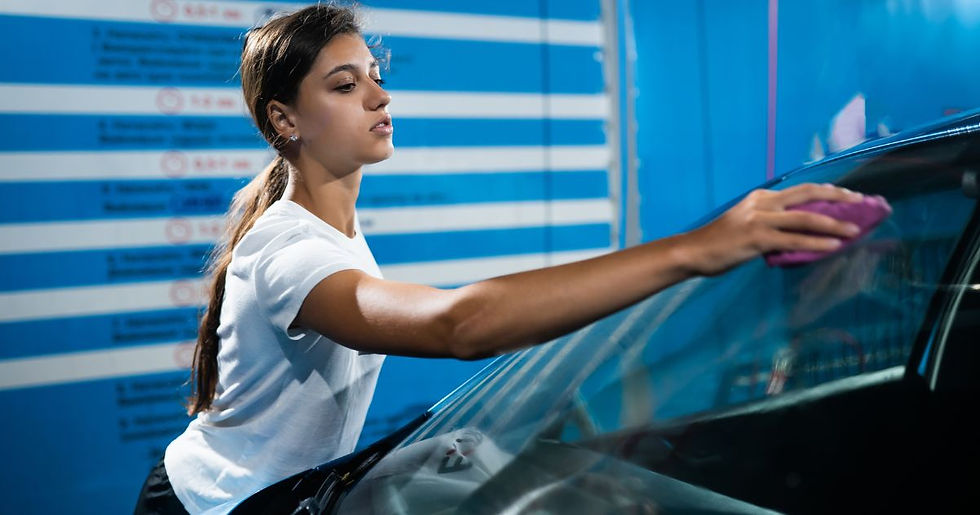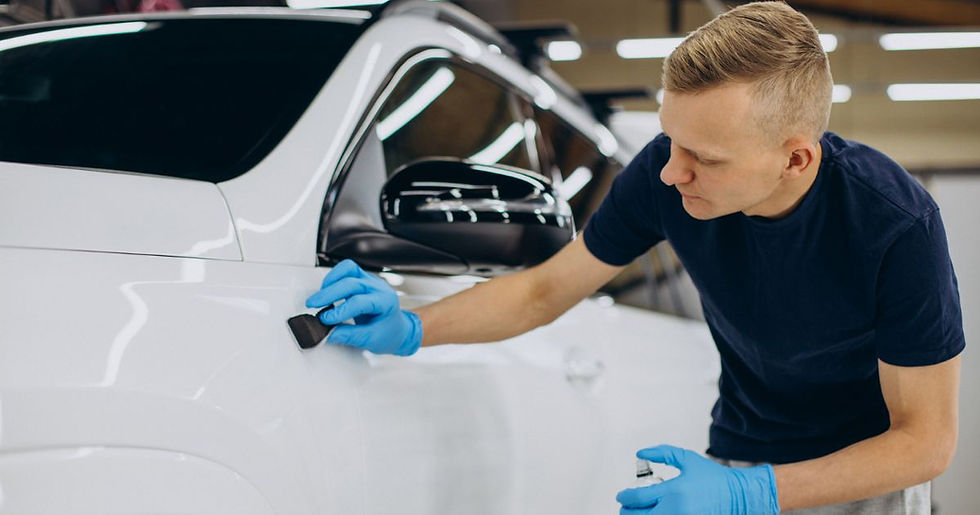Window Tinting vs Window Coverings: Which Is Best for Your Office?
- Alex
- 4 days ago
- 5 min read
In today’s fast-paced business world, the comfort, security, and energy efficiency of your office space are more important than ever. When it comes to controlling sunlight, reducing glare, and maintaining privacy, two main solutions often come to mind: window tinting and window coverings such as blinds or curtains.
While most people associate car window tinting with vehicles, the same technology can be applied to office windows, offering sleek, modern, and long-lasting benefits. On the other hand, traditional window coverings have been around for decades, providing a familiar way to manage light and privacy. But which is the better choice for your office environment?
In this guide, we’ll break down the differences between the two options, compare their benefits, and explore how they can even tie into wider services — from maintaining your business fleet’s MOTs to using a trusted garage for all-round vehicle care.

What Is Window Tinting?
Window tinting involves applying a thin, transparent film to glass surfaces, either on cars, homes, or offices. The film can block harmful UV rays, reduce glare, and improve insulation. In the automotive world, car window tinting services are extremely popular for both style and practicality, but its use in offices is growing rapidly.
Office window tints come in various shades and finishes, from almost invisible UV-protective films to darker tints that add privacy. Unlike curtains or blinds, they don’t take up space, require minimal maintenance, and maintain your view while still offering protection.
What Are Window Coverings?
Window coverings refer to traditional methods such as blinds, curtains, shutters, or shades. They work by physically blocking or filtering sunlight. Many offices opt for roller blinds or vertical blinds because they are affordable and easy to install.
However, while they can be replaced or changed to suit your décor, they tend to collect dust, fade over time, and may not be as effective at heat and UV control compared to window tinting.
Comparing Aesthetics: Modern vs Traditional
If your office aims to project a modern, professional, and high-tech image, window tinting offers a sleek, minimalistic look. Tinted glass exudes sophistication and gives the impression of a high-end workspace.
In contrast, window coverings lean towards a traditional and customisable approach. With endless fabric and design choices, they can match almost any office interior style. However, they can look dated more quickly and require more frequent cleaning.
Energy Efficiency and Cost Savings
One of the biggest reasons offices choose window tinting is energy efficiency. High-quality tints can reflect up to 80% of the sun’s heat, meaning your office stays cooler in summer and warmer in winter. This reduces reliance on air conditioning and heating systems — a significant saving on energy bills.
Window coverings can help too, but they often allow heat to build up between the covering and the glass. This means they are less effective at temperature regulation, and your HVAC system still works harder.
Privacy and Security
Privacy is essential in offices, especially if you deal with confidential documents or client meetings. Car window tinting technology, when applied to buildings, can give you one-way visibility during the day — you can see out, but outsiders can’t see in.
Curtains and blinds can block the view entirely, but they also block natural light, leaving your office feeling darker and more enclosed.
Maintenance and Longevity
A major advantage of window tinting is low maintenance. Once installed, it only requires occasional cleaning with a soft cloth and mild detergent. High-quality films can last 10–20 years without fading or peeling.
Window coverings, on the other hand, need regular cleaning to prevent dust build-up, and fabrics may need replacing every few years due to wear, tear, and fading from sunlight.
Cost Considerations
The initial cost of professional window tinting for an office can be higher than installing blinds, but it is a one-time investment with long-term benefits. Lower energy bills, reduced glare, and extended furniture life all contribute to cost savings over time.
Window coverings are cheaper upfront, but may cost more in the long run due to replacements, cleaning, and less effective temperature control.
Incorporating Car Window Tinting in Your Business Fleet
If your company operates vehicles — whether for deliveries, sales, or service — professional car window tinting can enhance both style and functionality. Tinted windows protect drivers from glare, keep interiors cooler, and help maintain a professional image when visiting clients.
For example, if your business manages multiple company cars or vans, you could combine office tinting with car window tinting for a consistent, branded appearance across your operations.
The Role of MOTs and a Trusted Garage
While discussing vehicle enhancements like car window tinting, it’s worth noting the importance of keeping your business vehicles roadworthy. Annual MOTs are a legal requirement in the UK for most vehicles over three years old, ensuring they meet safety and environmental standards.
Partnering with a reliable garage for MOTs, repairs, and regular servicing means your vehicles will always be in top condition. This not only supports your business image but also ensures compliance with the law. Combining services — such as having a garage handle both MOTs and car window tinting — can save time and streamline maintenance schedules.
Environmental Benefits
Sustainability is becoming a key consideration for businesses. By reducing the need for heating and cooling, window tinting helps cut carbon emissions. It’s a small change that can make a significant impact over time.
While some window coverings are made from eco-friendly materials, their shorter lifespan and replacement cycle may result in higher waste over the years.
Situations Where Window Coverings Win
Despite the advantages of window tinting, there are situations where traditional coverings are preferable:
Flexible light control: You can adjust blinds or curtains instantly for total darkness, which is ideal for presentations or video conferencing.
Budget constraints: For smaller offices or temporary setups, blinds may be the most cost-effective option.
Decor-focused spaces: If interior design is a priority, window coverings allow you to incorporate textures, colours, and patterns into the space.
Situations Where Window Tinting Wins
Window tinting is best suited for:
Permanent office spaces where long-term benefits outweigh the initial cost.
High-glare environments, such as offices with large south-facing windows.
Businesses prioritising energy savings, employee comfort, and a modern aesthetic.
Security-conscious companies needing daytime privacy without losing natural light.
Making the Right Choice for Your Office
Ultimately, the decision between window tinting and window coverings comes down to your office’s specific needs, budget, and style preferences. Many modern businesses actually combine both solutions — using tinting for overall energy efficiency and privacy, while keeping blinds or curtains for specific situations.
Conclusion
When it comes to creating a comfortable, stylish, and productive office environment, both window tinting and window coverings have their place. Car window tinting technology offers a sleek, low-maintenance, and energy-efficient solution, while traditional coverings provide flexibility and design versatility.
For businesses that also manage company vehicles, it makes sense to work with a trusted garage that can handle both MOTs and car window tinting, ensuring your office and fleet reflect the same professional standards.
By weighing up the benefits and limitations of each option, you can make a smart, long-term choice that improves both the comfort and image of your workspace.

Comments